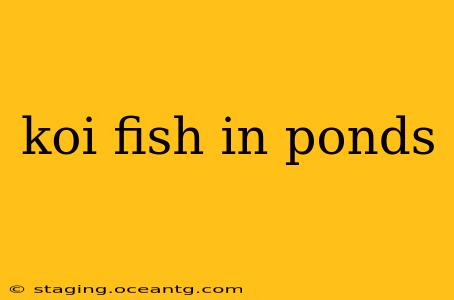Koi fish, with their vibrant colors and graceful movements, are a stunning addition to any pond. These captivating creatures, prized for their beauty and longevity, require careful consideration and planning to thrive. This comprehensive guide delves into everything you need to know about keeping koi fish in your pond, ensuring their health, happiness, and vibrant display for years to come.
What are the different types of Koi fish?
Koi fish are actually a type of carp ( Cyprinus carpio), selectively bred over centuries to exhibit a stunning array of colors and patterns. There are numerous varieties, each with its unique characteristics. Some popular types include:
- Kohaku: A classic with a white base and red markings.
- Sanke: Similar to Kohaku but with black markings added.
- Showa Sanshoku: A black base with red and white markings.
- Utsurimono: Featuring a dark base color (usually black) with contrasting markings.
- Bekko: A tortoise-shell pattern with a solid color base and blotches of a different color.
Many other variations and sub-varieties exist, each with its own beauty and appeal. Choosing the right type will depend on your personal preferences and the overall aesthetic of your pond.
How much space do Koi need in a pond?
The size of your pond is crucial for the well-being of your koi. Overcrowding leads to stress, disease, and poor water quality. A good rule of thumb is to allow at least 100 gallons of water per koi for smaller ponds. Larger ponds with sophisticated filtration systems can support higher stocking densities. Remember, koi grow significantly, so plan for their future size. You should also consider the depth of your pond; koi need enough room to swim and avoid predators.
What is the best type of pond for Koi?
While several pond types can house koi, a properly constructed and maintained liner pond is generally recommended for beginners. These ponds offer flexibility in size and design and are relatively easy to set up. However, it is also crucial to consider:
- Filtration: A robust filtration system is essential to maintain water quality, removing waste and debris. Biological filtration is particularly important to break down harmful ammonia.
- Aeration: Adequate aeration supplies oxygen to the water, crucial for koi health, especially in warmer months.
- Depth: A minimum depth of 3-4 feet is generally recommended to protect your koi from freezing temperatures in winter and to provide them with a sense of security.
What do Koi fish eat?
Koi are omnivores with varied dietary needs. A balanced diet should include:
- High-quality koi pellets: These provide essential nutrients and should form the bulk of their diet.
- Supplementary foods: Occasional treats like blanched vegetables (peas, lettuce) and high-quality fish flakes can add variety.
- Avoid overfeeding: Overfeeding leads to water pollution and health problems. Feed only what they can consume in a few minutes.
How often should you clean a Koi pond?
Regular maintenance is critical for a healthy koi pond. This includes:
- Regular water testing: Monitor ammonia, nitrite, and nitrate levels regularly.
- Filter cleaning: Clean or replace filter media as needed, following the manufacturer's instructions.
- Partial water changes: Perform partial water changes (20-30%) every few weeks to remove accumulated waste.
- Debris removal: Regularly remove leaves, algae, and other debris from the pond.
How long do Koi fish live?
With proper care, koi can live for many decades, some even reaching ages over 200 years. Their lifespan depends heavily on pond conditions, diet, and overall health.
What are some common Koi diseases?
Koi, like other fish, are susceptible to various diseases. Common problems include:
- Bacterial infections: Often caused by poor water quality or stress.
- Parasitic infestations: Treatable with medication.
- Fungal infections: Usually a secondary infection following injury or stress.
Regular observation, proper water quality maintenance, and prompt treatment are vital for preventing and managing these diseases. If you observe any unusual behavior or physical changes in your koi, consult a veterinarian specializing in aquatic animals.
Conclusion:
Keeping koi fish in your pond can be a rewarding experience, bringing years of enjoyment and beauty to your outdoor space. By following these guidelines and providing proper care, you can ensure your koi thrive, adding vibrant color and peaceful movement to your backyard paradise. Remember, research is key; the more you learn, the better prepared you'll be to provide the best possible environment for your stunning aquatic companions.
